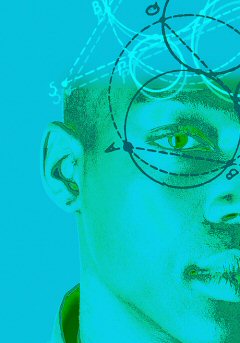29 June 2005
Brain Thrives On Constant, Chaotic Communication
By Rusty Rockets
 It may be that the concept of the mind working in the same way as a computer has had its day. Until recently, it was considered that the mind worked by progressing through a series of distinct brain states, analogous to the binary states of a computer. While this theory was an important stepping-stone in cognitive science, a new study published in the Proceedings of the National Academy of Sciences, indicates that the mind should be thought of more as a dynamic continuum, cascading through shades of gray.
It may be that the concept of the mind working in the same way as a computer has had its day. Until recently, it was considered that the mind worked by progressing through a series of distinct brain states, analogous to the binary states of a computer. While this theory was an important stepping-stone in cognitive science, a new study published in the Proceedings of the National Academy of Sciences, indicates that the mind should be thought of more as a dynamic continuum, cascading through shades of gray.
In the new study, Michael Spivey, a psycholinguist at Cornell University, tracked the mouse movements of undergraduate students while they worked at a computer. The findings provide compelling evidence that language comprehension is a continuous process. "For decades, the cognitive and neural sciences have treated mental processes as though they involved passing discrete packets of information in a strictly feed-forward fashion from one cognitive module to the next or in a string of individuated binary symbols - like a digital computer," said Spivey. He claims that a growing number of studies point to the brain operating via more organic, chaotic paths. "In this model, perception and cognition are mathematically described as a continuous trajectory through a high-dimensional mental space; the neural activation patterns flow back and forth to produce nonlinear, self-organized, emergent properties - like a biological organism."
The study asked 42 students to respond to audio cues by clicking on pictures of different objects on a computer screen. When the students heard a word, such as "candle," and were presented with two pictures whose names did not sound alike, such as a candle and a jacket, the trajectories of their mouse movements were relatively straight and went directly to the candle. But when the students heard "candle" and were presented with two pictures with similarly sounding names, such as candle and candy, they were slower to click on the correct object, and their mouse trajectories were much more curved.
"When there was ambiguity, the participants briefly didn't know which picture was correct and so for several dozen milliseconds, they were in multiple states at once. They didn't move all the way to one picture and then correct their movement if they realized they were wrong, but instead they traveled through an intermediate gray area," explained Spivey. The study found that because sensory input is processed continuously, even partial linguistic input can start "the dynamic competition between simultaneously active representations." This was evident in the way the students began processing before the entire word had been recognized. The results show that people are continuously processing, analyzing and cataloguing the world around them said Spivey. "Rather then working like a computer, where individual modules do their work on their own before transmitting results to one another, the brain is better described as an interactive dynamical system composed of subsystems that influence one another continuously."�
If the computer metaphor were used in this experiment, researchers would assume that any ambiguity on the part of the students would mean that the brain had simply made a mistake, equivalent to entering a 1 rather than a 0. In the computer analogy the brain decides between a number of static "on" or "off" values. "In thinking of cognition as working as a biological organism does, on the other hand, you do not have to be in one state or another like a computer, but can have values in between - you can be partially in one state and another, and then eventually gravitate to a unique interpretation, as in finally recognizing a spoken word," Spivey said.
Related reading:
A Computer In A Single Neuron
Source: Media release - Cornell University
